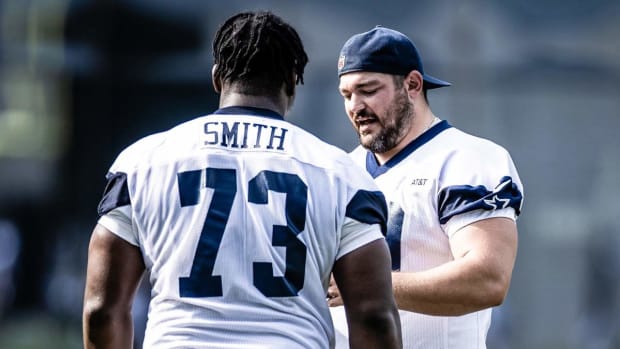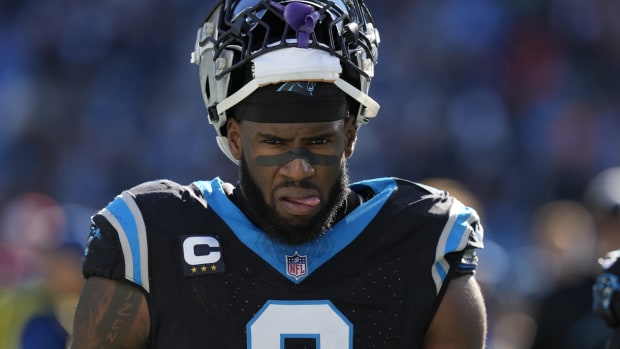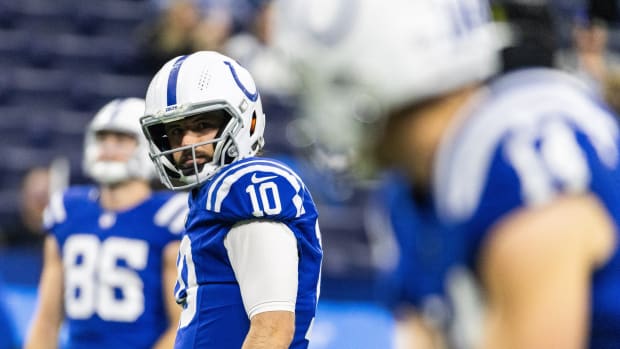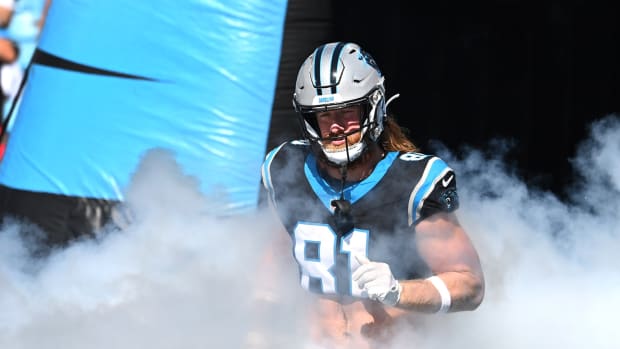The All-Undrafted Team: NFL’s Best Players Who Were Signed as Undrafted Free Agents
It’s time for rookie minicamps, with many teams hoping to emerge with a few undrafted gems to add to their rosters.
You have reached your limit of 4 premium articles
Register your email to get 1 more
With that, I present the Boise Scrappers, an imaginary expansion team from my hometown comprised of the top players currently in the NFL who were all signed as undrafted free agents. This team is built to fit a scheme best-suited for the players.
*Starters are listed in bold.
OFFENSE
QUARTERBACK
Nick Mullens, 49ers
Case Keenum, Redskins
Not to kick this off with a hot take, but Mullens last year showed the patience, pocket toughness and field vision of a future NFL starter. We know Keenum can orchestrate an offense, but it’d be one dependent on run-pass balance and defined reads. This team should see if Mullens can turn into the NFL’s next Tony Romo (yes, we realize the two players have completely different styles), and if it doesn’t work out, Keenum is waiting in the wings.
RUNNING BACK
Phillip Lindsay, Broncos
C.J. Anderson, Lions
Austin Ekeler, Chargers
Anderson was released after five seasons with the Broncos, and following brief stints with the Panthers and the Raiders, the running back landed with the Rams, where he became an integral part of their Super Bowl offense down the stretch. On this team I would want him in that same backup role he played behind Todd Gurley. Being a quality runner in the NFL requires the quickness and lateral agility to create your own space within confined areas. Lindsay has that. And with a sturdy rotational runner like Anderson and an electric receiving back like Ekeler, we could rotate enough to minimize the wear and tear on Lindsay’s slight frame.
WIDE RECEIVER
Adam Thielen, Vikings
Tyrell Williams, Raiders
Adam Humphries, Bucs
Robby Anderson, Jets
Thielen is a top-shelf superstar capable of aligning all over the formation, so the passing game will go through him. Williams is a somewhat unreliable, but scintillating, raw physical talent who works the intermediate and vertical levels. Play him alongside speedster Robby Anderson, and the defense is almost certain to employ a predictable two-deep look. Anderson gets the nod over Taylor Gabriel because he can run almost the entire route tree. If Thielen or Williams goes down, Anderson can plug in as the No. 2 and not miss a beat. If both starters are healthy, finding snaps for Anderson could be hard since Adam Humphries, with crucial shiftiness and over-the-middle awareness, is the slot guy. It pains me to leave Doug Baldwin off this team, but it looks like the Seahawks great has played his last football game.
TIGHT END
Jack Doyle, Colts
Cameron Brate, Bucs
Trey Burton, Bears
We’d create an emeritus-type coaching staff position for Antonio Gates, with the understanding that we’d sign him as a player if anyone got hurt from this group of players. Gates was still effective last year in a reduced role and has long been one of history’s greatest undrafted players (in any sport). But we need young bodies who can all handle 50+ snaps a game. Doyle is an excellent blocker and better receiver than he appears. Brate and Burton both offer receiving flexibility, in regards both to route running and where they can align. Neither is a dominant blocker, but we can feel OK with Burton in certain scenarios. And, with Develin aboard, we wouldn’t need either backup tight end in too many smashmouth situations anyway.
FULLBACK
James Develin, Patriots
You could go with an H-back here—Indy’s Ryan Hewitt has always been a good on-the-move blocker—but Develin is a better mover than realized, and as a straight lead-blocker, he’s football’s best. Putting two backs on the field in base situations, even if one of the backs is a classic fullback, simplifies the defense. I want to capitalize on that the way New England has.
OFFENSIVE LINE
LT Alejandro Villanueva, Steelers
LG Andrew Norwell, Jaguars
C David Andrews, Patriots
RG Patrick Omameh, free agent
RT Chris Hubbard, Browns
If you tell me I must go with Jason Peters, who is headed to the Hall of Fame and still performing at a high level in Philly, I wouldn’t complain. Villanueva, however, can be trusted on an island in most situations, and he’s six-and-a-half years younger than Peters. Norwell isn’t the stud that people think, but he’s still a quality blocker who can operate on the move and quietly thrive in pass protection. Andrews is a leader on the nearly-perennial World Champion Patriots who understands the game and plays beyond his athleticism. Having an intelligent center can be huge, especially when you have a young QB like Mullens.
When it comes to right guard, we can plug in Omameh now because he is less limited athletically than Cincinnati’s Alex Redmond, but I’d recommend to my GM that the team should consider signing left guards Lane Taylor of Green Bay or Ramon Foster of Pittsburgh with the hope that they could transition over to the right side.
Dallas’s La’el Collins was connected to a murder investigation right around draft time in 2015, causing him to fall not just out of the first round, but the draft altogether. You’d think he would be the easy choice at right tackle, but talent comes second to performance, and there’s no doubt that Hubbard, dating back to his days in Pittsburgh and last year in Cleveland, has been the better performer. He’s among the semi-rare NFL right tackles who can be trusted to pass-block one-on-one. We need that because Mullens looks more comfortable when all five of his eligible receivers are out in routes.
Backup offensive linemen
La’el Collins, Cowboys
Alex Redmond, Bengals
With limited active roster spots on Sunday, versatility is critical along your backup O-line. Collins can play tackle or guard and Redmond can play guard or center.
DEFENSE
DEFENSIVE LINE
Damon Harrison, Lions
Michael Bennett, Patriots
Michael Pierce, Ravens
Xavier Williams, Chiefs
It doesn’t matter if this team runs a 4–3 or a 3–4 defense—what does matter is whether the team will employ one-gap principles (like a 4–3 team) or two-gap principles (like a 3–4). In a two-gap scheme, linebackers, instead of firing their gun, read the action and play off it accordingly—and few defenses go two-gap anymore. We won’t be GREAT at linebacker, so I’d like to limit how heavily we burden that position. That said, Damon Harrison and Michael Pierce are too good to pass up, and we understand that with them on the field, we might wind up playing more two-gap concepts than expected. We can live with that. In pro football, “scheme fit” trumps talent more often than people realize, but “scheme fit” should only be taken so far.
As for Bennett, he’s still remarkable, especially as an interior pass rusher in long-yardage situations.
EDGE
Mario Addison
Shaquil Barrett
Cameron Wake
The two best players, Addison and Wake, are both in their 30s, yet neither show any sign of decline—Wake mostly because he’s had a reduced role the past few years, playing 25-30 snaps a game mainly as a pass rushing specialist. That playing time is fine because Barrett, who is also a decent pass rusher, can play on base down. He has spent his career in Denver’s 3–4, while Addison has been in Carolina’s 4–3, but again, those schematic labels get blown out of proportion. The biggest adjustment is that these men are all suited to play the weak side, and regardless of what scheme this team runs, one of them must play the strong side, across from the tight end. That only matters in base downs, however, and if the team chooses to just be a pure 4–3, we’d have an excellent strongside defensive end in Michael Bennett.
LINEBACKER
Wesley Woodyard, Titans
Cory Littleton, Rams
Vontaze Burfict, Raiders
Patrick Onwuasor, Ravens
Todd Davis, Broncos
Coverage ability is crucial at this position, as more offenses are featuring tight ends through the air and playing out of three-receiver sets. Woodyard is 32 but remains solid in coverage. Littleton is undersized but can also cover (for the most part). And if we have defensive tackles like Michael Pierce and Damon Harrison, we can assume run-blockers won’t be getting up to Littleton very often. Burfict is a gamble for reasons both related and unrelated to football. He played in nickel as a Bengal but is more of a true running down ‘backer. Same goes for Davis. He has improved in coverage but not enough that we can expect him to be ahead of Onwuasor on the nickel depth chart. Onwuasor, in fact, is a good blitzer who could sneak past Littleton into the starting lineup, depending on how important designer pressure packages are in our scheme.
CORNERBACK
A.J. Bouye, Jaguars
Chris Harris, Broncos
Malcolm Butler, Titans
Kenny Moore, Colts
J.C. Jackson, Patriots
Given the options at corner, it looks like the defense will be comfortable blitzing, but probably not built heavily on schemed pressure. (Then again, we might have to considering we lack a dominant pure pass rusher.) Blitzing requires lockdown cover corners who can handle receivers one-on-one, especially outside. Bouye has spent most his career in zone coverage, but with Houston it was a lot of matchup zone and in Jacksonville the zones often have man-to-man principles outside. We can feel good (enough) about him traveling with bigger No. 1 receivers and playing man. The question is Butler—on his best day, he’s shutdown caliber, but on his worst day, he’s a sieve. He’d be the nickel, playing outside with Bouye’s fellow starter, Chris Harris, sliding to the slot.
But part of the reason Butler is the nickel is he’s the only viable outside corner available, with the rest of the league’s good undrafted corners as slot defenders. In fact, it’s to such an overwhelming degree that you can actually say most of the NFL’s best slot men were undrafted: Harris, Kenny Moore, Bryce Callahan, Justin Coleman, Brian Poole, Mike Hilton and Nickell Robey-Coleman. Harris is the best all-around cover guy of that group (by far), while Moore is the best blitzer, tackler and zone defender.
We’re also prioritizing depth at this position, sacrificing one of our four safety positions for a fifth corner, J.C. Jackson. That’s because a.) we don’t fully trust Butler and would need a second perimeter corner if he falters and b.) Jackson in last year’s playoffs matched up to tight ends, including Chiefs superstar Travis Kelce for much of the AFC Championship. The main value of a safety in today’s NFL is having a guy who can cover tight ends.
SAFETY
Tashaun Gipson, Texans (FS)
Tony Jefferson, Ravens (SS)
Adrian Phillips, Chargers (box safety)
Gipson might be more of a box player than true centerfielder, but the only proven pure free safety in the pool of quality undrafted players is former Viking Andrew Sendejo, who comes with major injury concerns. Gipson has patrolled centerfield for much of his career, and we can feel OK with our strong safety, Jefferson, moving back there once in a while. Which means we have flexibility at safety, which can be invaluable. Buttressing that flexibility is that Gipson and Jefferson are both proven 1 on 1 tight end defenders in man coverage.
Phillips is an important player because with only so-so linebackers, the team will probably join the growing group of defenses that play a 3-CB, 3-S, 1-LB dime package on passing downs, as opposed to a 3-CB, 2-S, 2-LB nickel package. Phillips has been an excellent dime linebacker for the Chargers.
EXPECTATIONS
Obviously this team wants to win every game, but realistically, finishing somewhere in the nine- to 11-win range is reasonably optimistic, with much of the team’s performance riding on the largely unknown Mullens. The good news is we never have to worry about being accused of tanking because, as a team of all undrafted players, we don’t have a draft position.
Question or comment? Email us at talkback@themmqb.com.





































